Mushrooms and other fungi make up a large part of our world. Of the 14,000 species of documented mushrooms, only about 5% of them are considered “choice edibles”. One of the lesser-known types of edible fungi is the shimeji mushroom. Nutritious and delicious, shimeji mushrooms offer a whole new realm of fungal delight. Here, we’ll explore the types, uses, and other key information about the shimeji.
Types of Shimeji Mushrooms
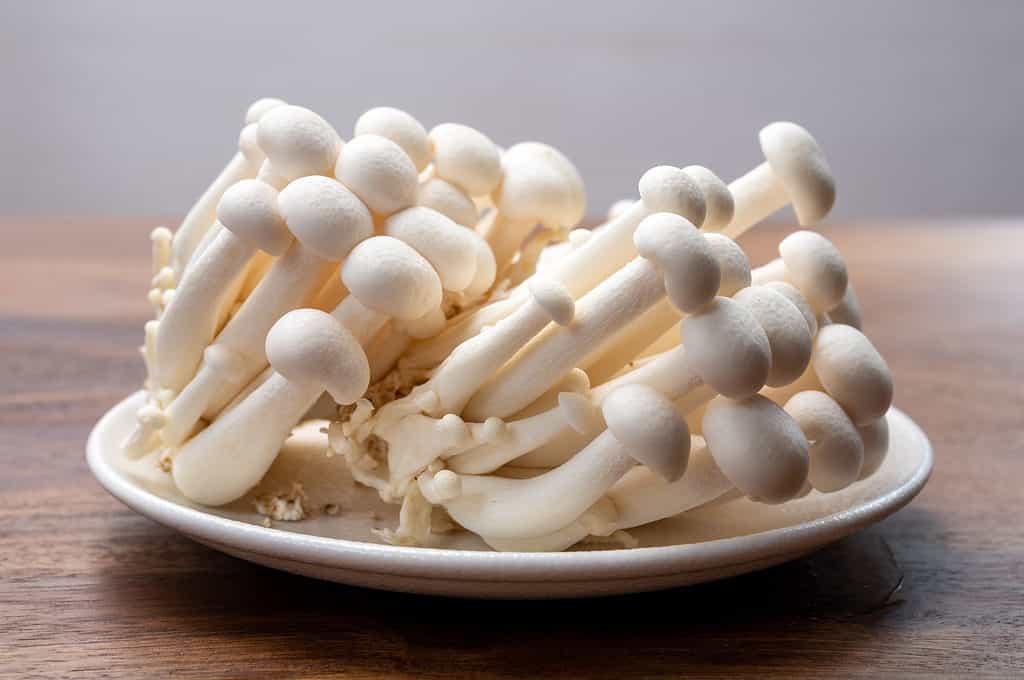
Bunapi-shimeji are an all-white variant of
Hypsizygus tessulatus.
©barmalini/Shutterstock.com
Before we dive in, let’s get to know the different varieties of shimeji. The name “shimeji” is an umbrella term for a couple different types of mushroom that are closely related, but feature key distinctions.
- Hon-shimeji, Lyophyllum shimeji: A wild species, hon-shimeji mushrooms grow singularly with oak or pine trees as a mycorrhizal fungus — meaning they grow symbiotically with a live plant rather than feeding on dead organic matter. This means that commercial cultivation isn’t currently possible. This wild species also varies in appearance, looking more like king oyster mushrooms than other shimeji types. Hon-shimeji feature a squat, white stem and brown cap.
- Buna-shimeji, Hypsizygus tessulatus: This branch of the shimeji umbrella is considered the “authentic” shimeji cultivars. Buna-shimeji grow in large clusters of small mushrooms on beech wood. Fun fact, buna-shimeji literally translates to “beech shimeji,” so we know its favorite food! Unlike hon-shimeji, buna-shimeji chooses dead or rotting wood to grow on, in classic saprotrophic fashion.
- Bunapi-shimeji is actually the same species as Buna-shimeji. It is just a different cultivar. Rather than brown caps, bunapi-shimeji feature a white cap for an all-white appearance. Bunapi are selectively grown from UV-irradiated buna-shimeji and were developed by the Hokuto Corporation.
Shimeji are also known by a number of other names, including beech mushrooms and clamshell mushrooms. Both the buna- and bunapi- types are also frequently referred to by their color. For example, buna-shimeji may be called brown beech or brown clamshell mushrooms, while bunapi-shimeji will be referred to as white beech or white clamshell mushrooms.
Key Identifying Factors
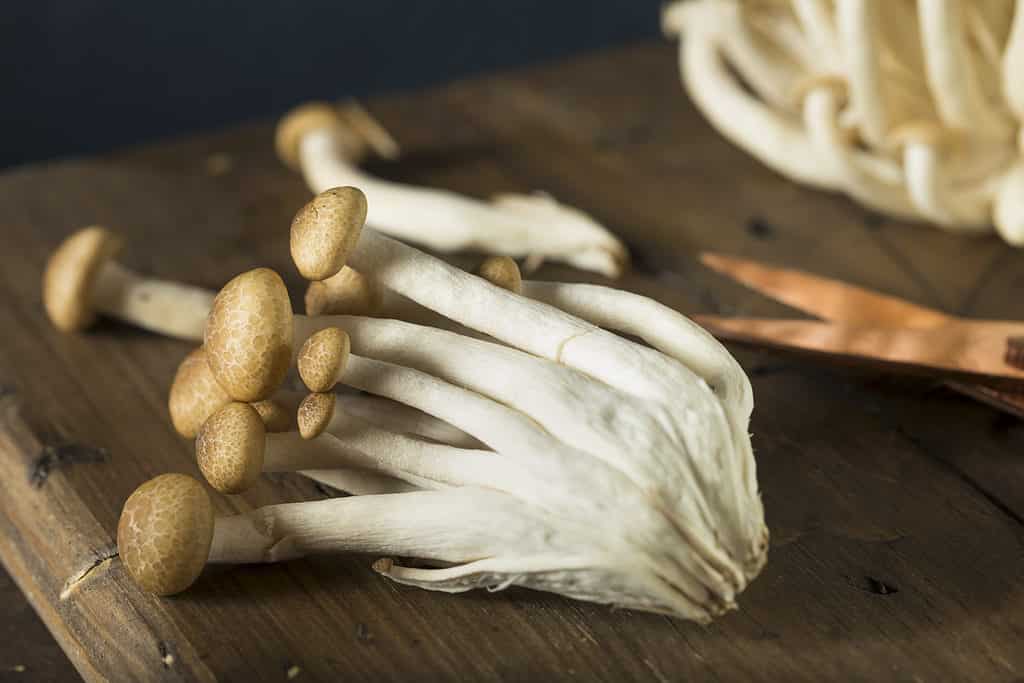
Buna-shimeji can have almost a marbled look to the cap.
©Brent Hofacker/Shutterstock.com
Commercially cultivated shimeji can look similar to some other cultivated mushrooms in the grocery store. To make it more difficult, they might even be sold under a generic non-explanative common name like “seafood mushrooms.” Enoki specifically can look quite similar. The long, creamy white stems start thick, then taper towards the small, convex-shaped cap. Most shimeji caps won’t get larger than about a couple of inches unless they are allowed to fully grow out and the mushrooms themselves can grow up to three inches tall.
For buna-shimeji, the tan-brown coloration can give almost marbled look, this may be somewhat due to moisture. The coloration on older buna-shimeji specimens often evens out to a smooth brown. The caps of bunapi-shimeji are white and have the same coloration as the stem.
Hon-shimeji look like large versions of the smaller shimeji types. Their large white stems are robust and stout, with a brown convex cap that tends to grow slightly larger than the circumference of its stem.
Where Do Shimeji Grow?

In the wild, hon-shimeji grow singularly, not in clusters.
©Marian Fil/Shutterstock.com
Hypsizygus tessulatus can be found in North America, mostly east of the Rockies. That said, they are much more well known in East Asia, primarily Japan, Korea, and parts of China. These cultures have revered edible mushrooms for hundreds of years. In Ancient China, mycology records extend to the 1200s, when mushrooms were thought of as elixirs and delicacies. Ancient Japan and Korea had similar relationships with edible mushrooms.
Today, shimeji mushrooms are cultivated throughout Asia, North America, Europe, and Australia. The clustered fungi can be found on many Asian grocery shelves but are also making their way to other grocery stores.
Are Shimeji Mushrooms Edible?
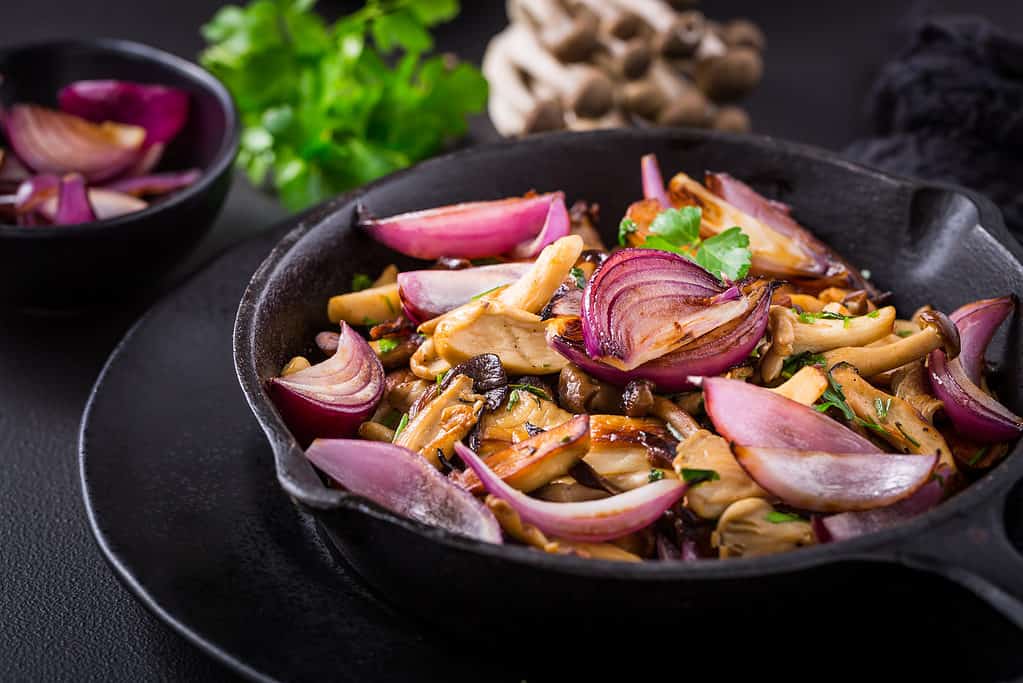
Shimeji mushrooms make great additions to a lot of different dishes.
©Ingrid Balabanova/Shutterstock.com
Yes! Though lesser known than some other types of mushrooms, such as shiitakes, oysters, or portobellos, shimeji play a starring role in many Japanese and other Asian dishes. These versatile fungi are known for their sweet smell, robust flavor, and slightly crunchy texture. Depending on how they’re prepared, the flavor of shimeji mushrooms has been described as nutty, savory, umami, and seafood-like. This makes them a favorite for those following a vegetarian or vegan diet.
Shimeji may be edible, but they should always be cooked before eating. When raw, they taste significantly more bitter and are harder for our bodies to digest.
Are Shimeji Mushrooms Healthy?
Shimeji mushrooms are packed with vitamins, nutrients, and flavor. In fact, several sources call them one of the most nutritious varieties of mushroom. Some benefits of adding shimeji mushrooms to your diet include:
- High in fiber
- Low calorie
- No cholesterol
- Contain protein
- Vitamins B vitamins and vitamin D
- Minerals zinc, selenium, potassium, phosphorus, copper, magnesium
The many beneficial properties of these mushrooms are thought to possibly help lower cholesterol, lower blood pressure, serve as anti-cancer agents, boost immune health, maintain thyroid function, and much more. Shimeji mushrooms also support digestive health with some natural prebiotic properties. With all these benefits and great flavor, you’ll want to add shimeji to every meal!
Buying and Using Shimeji Mushrooms
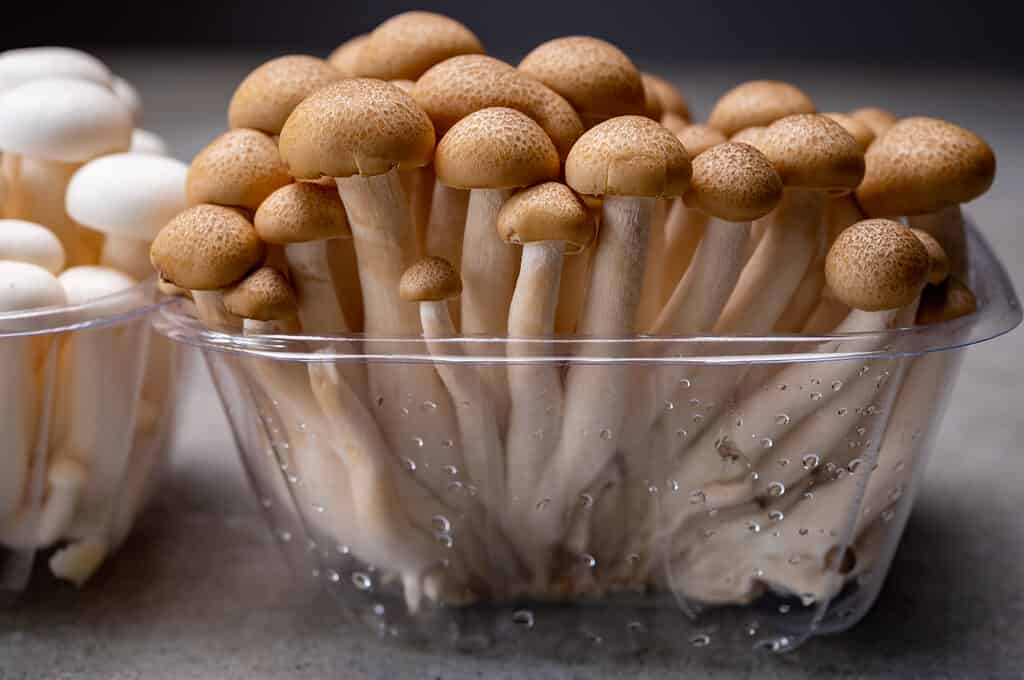
Fresh shimeji mushrooms come in plastic packaging to preserve their flavor and texture.
©barmalini/Shutterstock.com
Now a popular ingredient in many different dishes and cuisines, shimeji mushrooms are widely available. Most Asian groceries carry many types of mushrooms, including kinds of shimeji. Due to the mushroom’s growing popularity, some other groceries are also adding it to their repertoire. You can also find shimeji at a number of online retailers, including fresh, dried, and even canned or boiled.
Depending on which you choose, prices can vary a great deal. Hon-shimeji will naturally be much more expensive and harder to find due to the difficulty involved in cultivating it. Buna- and bunapi-shimeji are more comparable in price and similarly available.
When purchasing fresh shimeji, test the base for firmness. The caps should be intact and not shriveled. Avoid any signs of spoilage. Most fresh shimeji clusters will come wrapped in a loose plastic bag. This environment is ideal for shimeji to retain its firmness. Once open, wrap the base of any unused mushrooms in a moist paper towel and eat within five days for maximum flavor, but do not ever store your mushrooms in a sealed plastic bag.
To use fresh shimeji, simply chop the connective base off and separate the mushrooms. You can trim as much or as little of the stem as you like, as shimeji stems aren’t as tough as some other mushrooms. Dried mushrooms should be lightly rinsed, then can be reconstituted for use in a dish or simmered as part of a stock.
Cooking with Shimeji Mushrooms
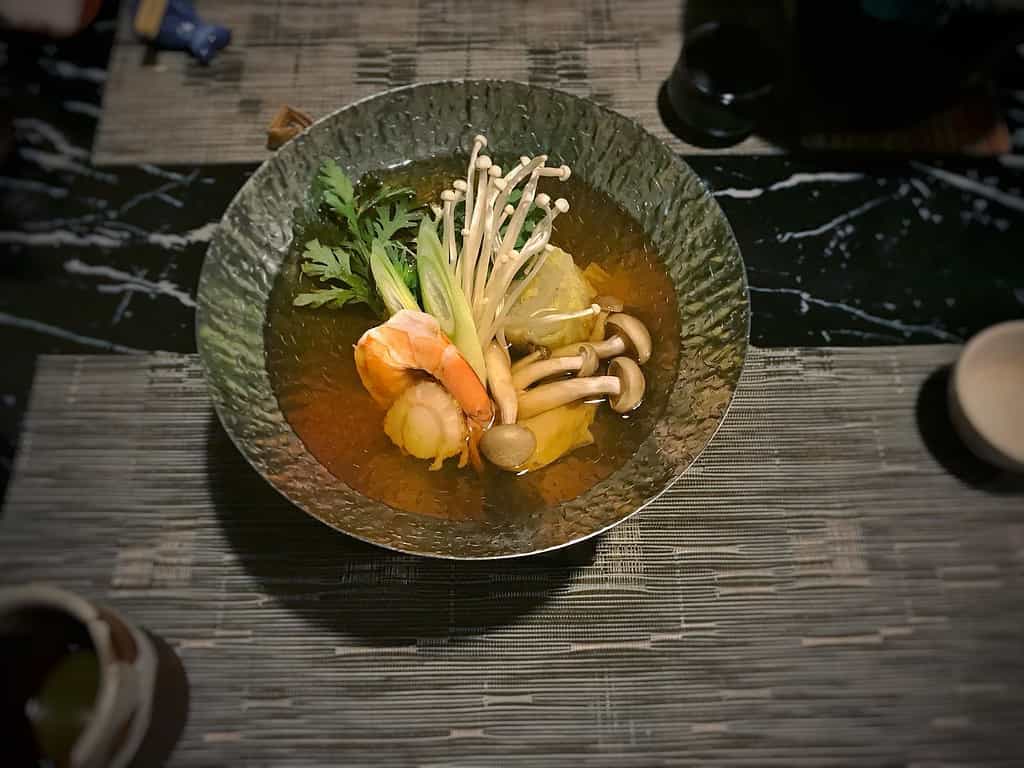
Shimeji mushrooms can be cooked and enjoyed in multiple ways, such as soups.
The versatility of these mushrooms makes them an ideal addition to any type of meal. The natural flavor of the mushroom shines when sauteed with butter or sesame oil. Grilling and roasting also brings out more of the mushroom’s nuttiness. The unique texture of shimeji also makes a great addition to soups and stews, as well as rice and noodle dishes.
Aside from being a great stand-alone ingredient, shimeji also brings a punch of flavor when used in a stock or broth. Some vegan or vegetarian recipes use them as an alternative when making “seafood” stocks. You can use either fresh or dried shimeji while simmering a stock for enhanced umami and depth of flavor.
Most mushrooms are hard to overcook — they just continue to lose moisture and shrink in size. However, with shimeji mushrooms, you want to be careful. Their delicious crunchy texture can easily be lost if cooked too long. If you’re looking for that texture in your dish, add the shimeji towards the end or cook first and set aside to add in later.
How to Grow Shimeji Mushrooms
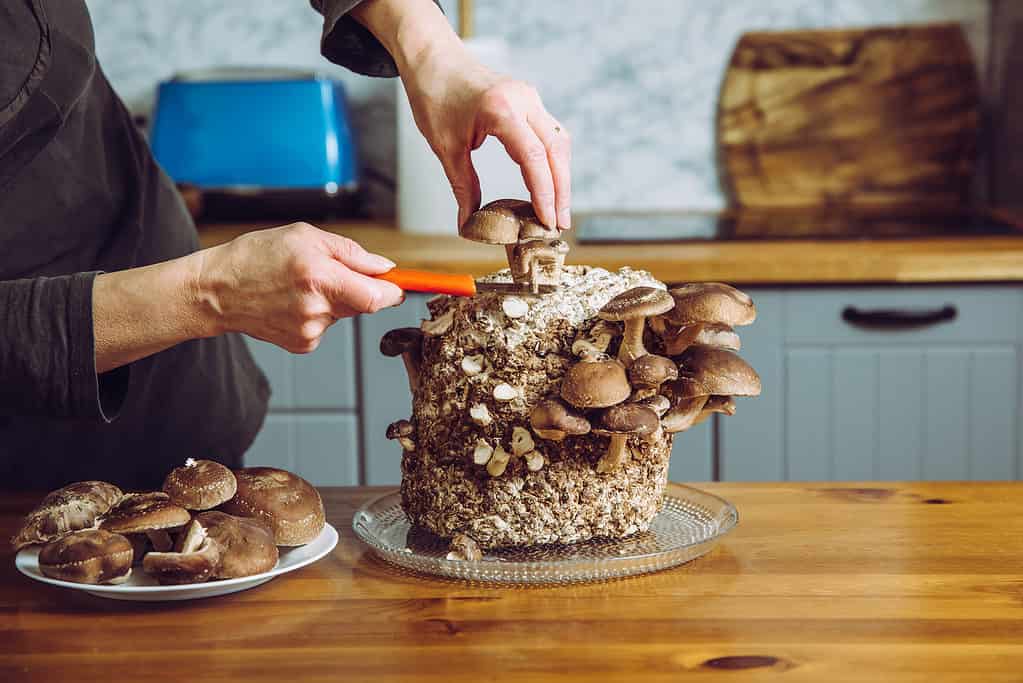
Growing mushrooms at home is a great way to guarantee access to fresh produce.
©FotoHelin/Shutterstock.com
If you’re new to growing mushrooms, experts recommend starting somewhere else — oysters and shiitakes are ranked as the easiest mushrooms to grow at home! Shimeji mushrooms grow much slower than other species and require more specific conditions to fruit. Though not impossible, mushroom growers rank shimeji as a medium difficulty to grow. However, if you’ve already had success with growing other mushrooms or shimeji are your favorite, there are multiple ways to grow these mushrooms.
Pre-inoculated grow kits offer the easiest and fastest way to grow shimeji mushrooms at home. These kits drastically cut down on the time to harvest. This mushroom waits until it fully colonizes its food source, also called substrate, before it will begin the fruiting process. Grow kits take out this waiting period by selling blocks or bags of already-colonized substrate. As the grower, all you have to do is place the kit in the proper conditions to induce fruiting. Your first flush of mushrooms will be ready to harvest in about two weeks!
Another indoor option adds more complexity but is no less rewarding. Growing shimeji mushrooms in grow bags or glass jars takes longer — the shimeji spawn needs time to fully colonize its food source before producing mushrooms. The spawn can take up to 2-3 months to fully colonize, depending on the conditions, and will begin fruiting in another two to three weeks.
As a last option, you can mimic the shimeji’s natural environment and grow the mushrooms outdoors on logs. Though this method can take up to two years to produce mushrooms, your logs will continue to provide you with delicious mushrooms for three to six years depending on size!
The information presented on or through the Website is made available solely for general informational purposes. We do not warrant the accuracy, completeness, or usefulness of this information. Any reliance you place on such information is strictly at your own risk. We disclaim all liability and responsibility arising from any reliance placed on such materials by you or any other visitor to the Website, or by anyone who may be informed of any of its contents. None of the statements or claims on the Website should be taken as medical advice, health advice, or as confirmation that a plant, fungus, or other item is safe for consumption or will provide any health benefits. Anyone considering the health benefits of particular plant, fungus, or other item should first consult with a doctor or other medical professional. The statements made within this Website have not been evaluated by the Food and Drug Administration. These statements are not intended to diagnose, treat, cure or prevent any disease.
Thank you for reading! Have some feedback for us? Contact the AZ Animals editorial team.








